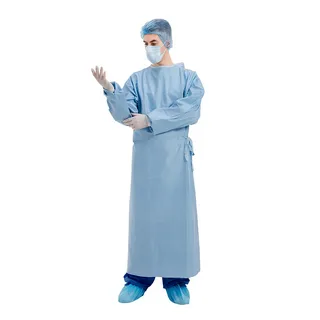Surgical gown is a vital part in personal protective equipment (PPE) in health care practice, especially in operational theatre. As the consciousness of infection preventing, safety rules and the necessity to sustain safety of medical workers and patients are being highly raising in Australia, this article will explore the conference value of surgical gown in medical culture, standards for it accords, different types of surgical gown and role in assures safety in health care practice.
The Importance of Surgical Gowns in Healthcare
Surgical Gown Australia act as a barrier that protects the wearer, the patient and working environment from contamination. They are using primarily to reduce the risk of infectious agent transfer by the operating team to the patient, and vice versa. Infections are spread through blood, bodily fluids and airborne pathogens, and protective garments are an important part of limiting contamination.
They, along with surgical gloves of a tight-fitting material with low permeability, prevent the physical crowding of microorganisms on the surface. Healthcare-associating infections (HAIs) are a common issue in Australia, with millions of dollars being spent each year to manage them and the risk they pose to patient lives is huge. Surgical gowns help create a physical barrier with the wearer to reduce the risk of contamination, and to that extent help create a safer healthcare environment.
Regulatory Standards for Surgical Gowns in Australia
All surgical gowns being using in Australia must be approving and regulating to ensure they have certain features and remain safe for use. In Australia, the Therapeutic Goods Administration (TGA) approve and regulate the manufacture, supply and use of therapeutic goods which includes medical devices such as surgical gowns.
These Australian standards are basing on international best practice. The Australian and international (ISO and ASTM) standards for surgical gowns include many elements. They are:
Barrier Performance: (6) Gowns shall demonstrate a capacity to resist fluid penetration, expressing in terms of the liquid volumes that will stain the gown during specific specifying procedures. Said volumes need to exceed those that can carry blood-borne pathogens.
Breathability and Comfort: As gowns are worn throughout the day, they need to be breathable while still providing high-level protection.
Durability: Gowns should be strong enough to withstand tearing and abrasion during use, especially in the fast-paced, sometimes frantic, clinical care setting that is the operating room.
Sterility: Before being using for surgery, surgical gowns need to be sterile to keep the sterility and safety of surgical areas.
The TGA also monitors these standards and the use of gowns in contemporary Australian healthcare facilities is restricting to those models that meet approving standards. Manufacturers and suppliers have to demonstrate compliance with these regulations. They know that providing the right PPE to healthcare workers is absolutely dependent on competent design and manufacture.
Types of Surgical Gowns
Types of surgical gowns using in Australia are dividing into two main categories in order to suit the need of the circumstances. These two categories are:
Disposable Surgical Gowns: This gown is designed to be using for single surgical operation. It can generally be made of plastic synthetic raw material like polypropylene, polyethylene etc. Disposable gowns become popular on the market due to its convenience, case of use. Also its use is essential reduce risk of cross-contamination. Once used, throw it away to prevent re-infection.
Reusable Surgical Gowns: Made from strong fabrics, such as polyester-cotton blends, reusable surgical gowns are designed to be washing and sterilizing multiple times. Such reusable gowns are more sustainable and more cost-efficient in comparison with disposable gowns in the long run. However, they do require strict cleaning protocols to ensure they remain sterilized and safe to use in the future.
there are two choices between disposable and reusable gowns that a person can choose for surgery. There are numerous determining factors in deciding between disposable and reusable gowns. if we pick the disposable gowns the person who receives surgery can avoid the pain and sickness. The reason usually the hospitals choose reusable gowns because these gowns are very much costly and the hospitals must use this gowns daily the doctors and nurses contain it in hospital bins and disposed them. I personally preferable to use our own disposable gowns. In this we will protect and preserve the environment.
Impact of the COVID-19 Pandemic on Surgical Gown Usage
Demand for such Surgical Gown Scrub has increased significantly in recent times due to the COVID-19 pandemic. During the height of the pandemic, many parts of the world experienced severe shortages of personal protective equipment (PPE), including surgical gowns. Beyond providing a basic level of hygiene for the wearer, the use of surgical gowns demonstrates the importance of adequately protecting humans from highly infectious agents.
In response, Australian manufacturers ramped up production of surgical gowns, and the government implemented policies to maintain the supply chain of PPE. This resounding call to action raised awareness about the significance of maintaining domestic manufacturing capacity, especially regarding the country’s critical healthcare supplies and dependence on imports.
Conclusion
With increased requirements for safety, infection-control standards require surgical gowns to be worn in Australian hospitals. Through rigid regulation and standards, surgical gowns are produced to the highest quality and protect both doctors and patients who they work on each day from potential infections. With the progress of the field of healthcare, demand for quality, durable and comfortable disposable and reusable surgical gowns will continue to be an integral factor in delivering safe and successful medical care throughout the country, ensuring the sterilized and safe nature of the medical setting, protecting lives and ensuring a healthy future for Australians.




